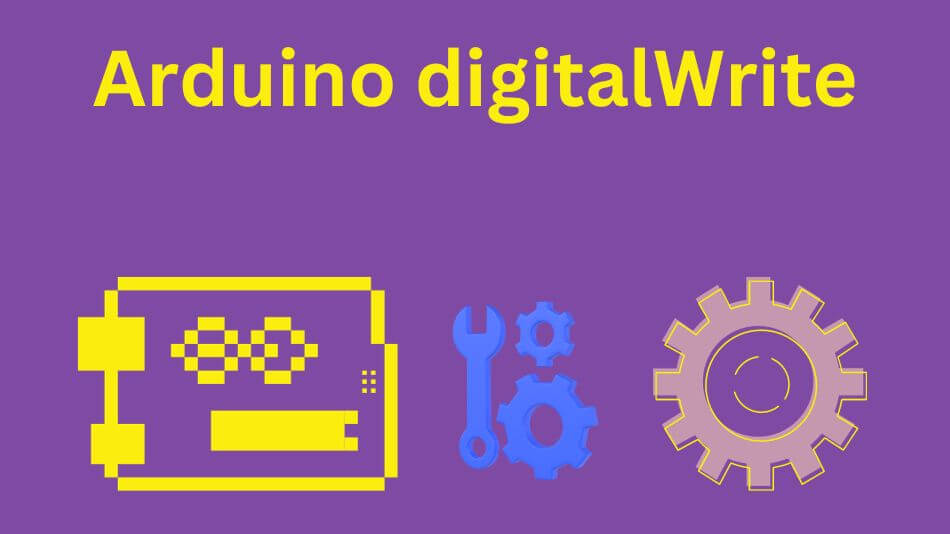Introduction

Arduino has revolutionized electronics and DIY projects, empowering enthusiasts to craft everything from LED blinkers to complex robotic systems with its digitalWrite function at its heart.
We will explore this fundamental aspect of Arduino programming in depth in this guide and help you gain a full appreciation of all its nuances while unlocking its full potential.
Understanding Arduino digitalWrite
What is Arduino digitalWrite?
Arduino digitalWrite is a powerful function that lets you control the state of digital pins on your Arduino board.
It’s the gateway to making your projects interactive and responsive.
This function can turn LEDs on and off, control motors, communicate with other digital devices, and more.
How does digitalWrite work?
At its core, digitalWrite sets the voltage level of a specified digital pin to either HIGH or LOW.
When set to HIGH, the pin outputs +5V (or the board’s supply voltage); when set to LOW, it outputs 0V (ground). This simple mechanism forms the basis for controlling various electronic components.
Getting Started with Arduino digitalWrite
Setting up your Arduino Environment
Before diving into the intricacies of digitalWrite, make sure you have the following:
- An Arduino board (e.g., Arduino Uno, Nano, or Mega).
- The Arduino IDE (Integrated Development Environment) is installed on your computer.
- A USB cable to connect your Arduino to your computer.
Writing Your First digitalWrite Code
Let’s start with a simple example. Open the Arduino IDE, create a new sketch, and write the following Code:
The code
int ledPin = 13; // Define the digital pin connected to the LED
void setup() {
pinMode(ledPin, OUTPUT); // Set ‘ledPin’ as an output
}
void loop()
{
digitalWrite(ledPin, HIGH); // Turn the LED on
delay(1000); // Wait for one second
digitalWrite(ledPin, LOW); // Turn the LED off
delay(1000); // Wait for one second
}
Uploading and Running the Code
- Connect your Arduino board to your computer using the USB cable.
- Select the correct board and port in the Arduino IDE.
- Click the “Upload” button to upload the Code to your Arduino.
- Watch as the onboard LED on pin 13 blinks on and off at one-second intervals.
Congratulations! You’ve just mastered your first digitalWrite project.
Advanced Techniques with Arduino digitalWrite
Pulse Width Modulation (PWM)
Arduino digitalWrite is not limited to just turning things on and off; it can also produce a range of analog-like outputs using Pulse Width Modulation (PWM).
This is incredibly useful for controlling things like brightness in LEDs and the speed of motors.
Controlling Multiple Pins
You can control multiple pins simultaneously using arrays and loops. This feature simplifies the management of complex projects.
Using External Components
Digital pins can be used to communicate with a wide range of external components, such as sensors, displays, and relays. This expands the possibilities for your Arduino projects exponentially.
Frequently Asked Questions (FAQs)
What is the difference between digitalWrite and ‘analogWrite’?
digitalWrite is used for digital pins, producing either a HIGH or LOW output. In contrast, analogWrite is used for Pulse Width Modulation (PWM) pins to produce analog-like outputs with variable intensity.
Can I use digitalWrite with any digital pin on my Arduino board?
Yes, you can use digitalWrite with any digital pin that supports digital I/O operations.
However, some pins have specific functions on certain Arduino boards, so refer to your board’s documentation for details.
How do I troubleshoot digitalWrite issues in my project?
Common issues include incorrect pin assignments, hardware problems, or conflicts with other Code. Double-check your connections and Code, and consult the Arduino community for assistance.
Are there any safety precautions to consider when using digitalWrite?
Yes, be mindful of voltage levels and current requirements of the components you’re controlling. Incorrect configurations can damage your Arduino or connected components.
Conclusion
In this extensive guide, we’ve explored the ‘Arduino digitalWrite world and its vast potential in creating interactive and responsive projects.
This function is at the heart of Arduino programming, from basic LED blinking to advanced PWM control.
Armed with this knowledge, you’re now equipped to embark on your own exciting Arduino adventures.
So go ahead, unleash your creativity, and make your ideas come to life with Arduino digitalWrite!
